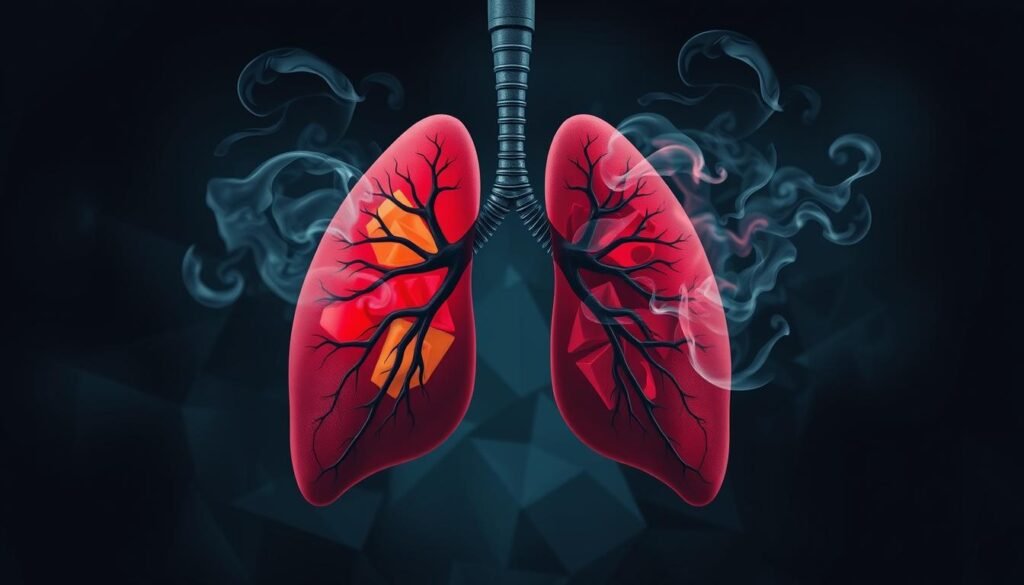In 2020, 2,206,771 new cases of lung cancer were reported worldwide. This number shows the big impact of lung cancer on public health. Vaping is getting more popular, especially among young adults. This raises questions about its link to lung cancer. Research suggests that individuals using both cigarettes and e-cigarettes have a higher lung cancer risk than those who just smoke. Since nicotine addiction plays a role in vaping, it’s crucial to understand vape health risks. We need this knowledge to fight this modern health issue. This article explores research on vaping and lung cancer, and what it means for individual and public health.
Key Takeaways
- In 2020, over 2 million new lung cancer cases worldwide signaled a warning about vaping and lung cancer.
- The rise in e-cigarette use among young adults comes with serious health risks.
- Research links a higher risk of lung cancer to using both cigarettes and e-cigarettes.
- Understanding vaping risks is key to prevention.
- The long-term effects of vaping on lung health are still not fully understood.
The Rising Popularity of Vaping
In recent years, vaping popularity has dramatically increased among young people. This has made it a top choice for teens looking for smoking alternatives. From 2011 to 2015, e-cigarette use among high school students in the United States jumped by 900%. Many believe vaping is safer than traditional cigarettes, contributing to the youth vaping epidemic.
Vaping, while seen as a modern choice, brings up big health worries. Most e-cigarettes have nicotine, like regular cigarettes, which could lead to addiction. They also produce dangerous aerosols with chemicals, posing similar health risks to smoking.
The trend of vaping is attracting both non-smokers and young people alike. It’s important to know the health dangers that come with it. Continued research is key to understanding and tackling the youth vaping epidemic.
Understanding Vaping Products
Vaping products, like e-cigarettes, have become very popular. They mostly have nicotine, water, flavorings, and humectants. Knowing what’s in them helps us understand their health risks.
When people use e-cigarettes, they breathe in an aerosol. This aerosol can have harmful chemicals like acetaldehyde and formaldehyde. These can cause breathing problems, heart disease, and lung injuries. A study shows two e-cigarette ingredients, propylene glycol and vegetable glycerin, can be cell toxins.
E-cigarettes are risky, not just for the user but for others too. Secondhand emissions have nicotine, ultrafine particles, and heavy metals like lead. This makes it important to study e-cigarettes, especially in public.
The National Academies of Sciences, Engineering, and Medicine report suggests e-cigarettes are marketed as safer than smoking. But, the FDA hasn’t approved them as quit-smoking aids. People should know the health risks before using vaping products.
| Component | Function | Health Risks |
|---|---|---|
| Nicotine | Addictive stimulant | Increased heart rate, addiction potential |
| Water | Base for aerosol | Safe in isolation; potential for irritation |
| Flavorings | Enhance taste | Some may be toxic; linked to lung injury |
| Humectants | Retain moisture | Toxic to cells (propylene glycol, vegetable glycerin) |
As new vaping products appear, it’s key to understand what’s in them. Everyone should know about the risks and the need for more research.
Vaping and Lung Cancer: What Research Shows
Vaping has caught many people’s attention due to health concerns. There’s a growing body of research on how it might affect lung cancer risks. Figuring out these connections is crucial as more information becomes available about the dangers involved.
Recent Studies on the Correlation Between Vaping and Lung Cancer Risks
Recent studies show a clear link between vaping and higher lung cancer risk. People who both smoke and vape are four times more likely to develop lung cancer than those who only smoke. Another striking finding is that lung cancer patients are eight times more likely to have used both cigarettes and e-cigarettes.
The vapor from e-cigarettes has many chemicals that can cause serious health problems, including cancer. The nicotine in e-cigarettes makes them addictive, making it hard for users to quit. This leads to more health risks from long-term use.
Dual Use of Cigarettes and E-Cigarettes
The combined use of cigarettes and e-cigarettes greatly increases lung cancer risk. While some smokers turn to vaping to help quit, they often end up continuing their nicotine addiction. Studies show worrying trends for people who use both.
Long-term smoking and vaping can seriously harm the lungs. This underscores the need for more research. As vaping habits change, understanding the full extent of risks is key for public health advice.
| Usage Type | Lung Cancer Risk | Percentage Increase in Risk |
|---|---|---|
| Only Smoker | Baseline Level | 0% |
| Only Vaper | Uncertain (limited research) | N/A |
| Dual User | Significantly Higher | 400% |
| Lung Cancer Patients | High Risk | 800% |
Health Risks Associated with Vaping
Vaping has become more popular, which raises serious health issues. Both short-term effects and long-term risks harm respiratory health. Early symptoms like coughing and difficulty breathing lead to discomfort. Over time, vaping could cause serious lung diseases and higher cancer risks.
Short-Term and Long-Term Effects on Respiratory Health
It’s important to know the vaping health risks for public awareness. Short-term irritation might seem minor but can turn into long-term airway inflammation. This can start the process of cancer formation. Studies show vaping worsens lung function over time. This damage is something to think about, especially for those who see e-cigarettes as safer than smoking.
Specific Compounds in Vaping Products Linked to Health Risks
Studies have found harmful substances in many vaping products. E-cigarettes have carcinogenic compounds and poisons that greatly add to the vape health impacts. They contain nicotine by-products, heavy metals, and known cancer-causing agents. Being exposed to these substances over time can harm cells, leading to severe health problems like lung cancer. As vaping products change, we must keep studying and talking about their dangers.

Misconceptions About Vaping Safety
Vaping is often discussed in public health talks. But, there are many myths about its safety compared to smoking. People think e-cigarettes are safe because they don’t have tobacco. Yet, research shows vaping can still be harmful. It may have fewer risks than smoking, but there are still dangers involved.
The way people view vaping affects its perceived safety. From 2013 to 2017, the number of adults who thought e-cigarettes were as harmful as cigarettes jumped from 7% to 26%. This shows how important accurate information is. Correct facts might change how people think about vaping, especially regarding quitting smoking.
There’s a false belief that e-cigarette vapor is not dangerous to others. But studies show e-cigarette aerosol still has risks, just less than cigarette smoke. This myth causes needless worry for non-smokers who are around vaping. Knowing the truth can help people make better choices.
Vaping is often used to stop smoking, as mentioned in public documentation. In 2015, in England, vaping helped increase the number of people who stopped smoking for good by about 18,000. Many say vaping played a big role in their ability to quit. This has led to better health for those individuals.
Even with studies showing vaping is somewhat safer than smoking, wrong ideas still exist. These false beliefs affect how people see vaping. It’s crucial to keep educating about e-cigarettes. This education helps clear up myths. Through ongoing talks, we can show vaping’s role in quitting smoking more accurately.
| Vaping Myths | Facts |
|---|---|
| E-cigarettes are completely safe. | E-cigarettes can contain harmful chemicals and carcinogens. |
| E-cigarette vapor is harmful to bystanders. | E-cigarette aerosol poses a lower risk to others compared to secondhand smoke from cigarettes. |
| E-cigarettes are just as harmful as traditional cigarettes. | The lifetime cancer risk for e-cigarette use is significantly lower than that of smoking. |
| E-cigarettes do not help with smoking cessation. | E-cigarettes have aided thousands in quitting smoking effectively. |
The Connection Between Nicotine Addiction and Lung Cancer
Nicotine addiction boosts the lung cancer risk among traditional cigarette and e-cigarette users. Some view vaping as a safer choice. However, it still gives nicotine, which is highly addictive. This addiction makes users stick with tobacco longer. As a result, they face more harmful chemicals. E-liquids contain dangerous stuff like propylene glycol and heavy metals, raising health risks.
Studies show e-cigarettes carry many of the same chemicals as regular cigarettes. Though in smaller amounts, they still threaten respiratory health and could lead to lung cancer. Take diacetyl in some e-liquids, for example. It’s tied to severe lung diseases, and breathing it in can harm your lungs more.
The CDC has flagged vaping-related lung illness, named EVALI, to highlight nicotine dangers. Nicotine exposure might cause tumors over time. There’s no direct link to e-cig cancer in humans yet. But, research on mice shows big concerns. For instance, 22.5% of mice using e-cig juice got lung cancer. This suggests vaping’s long-term effects might be as bad as smoking’s.
It’s key to tackle nicotine addiction to lower lung cancer risk. Smoking cessation programs need to help people dodge smoking and vaping. Using tried and true quit aids like nicotine therapies can help. We must see vaping as another form of nicotine addiction. This view is central to fighting lung cancer.

Creating strong smoking cessation programs is crucial for tackling these health issues.
Environmental Toxicants and Their Role in Lung Cancer Development
To understand lung cancer risks, we must look at environmental toxicants. There’s troubling evidence connecting e-cigarette ingredients to lung cancer. People exposed to carcinogens in vaping products face higher health risks. These include heavy metals and aldehydes.
Common Carcinogenic Compounds Found in E-Cigarettes
Studies show e-cigarettes have toxins that could increase cancer risk. These carcinogens include:
- Formaldehyde
- Diacetyl
- Aldehydes
- Heavy metals such as lead and cadmium
Diacetyl, tied to lung issues in factory workers, is in many e-cigarette flavors. This raises concerns about their safety and long-term effects. The discovery of these toxins calls for tighter e-cigarette regulations.
Impact of Air Pollution on Lung Cancer Risks
Air pollution is a big factor increasing lung cancer risk. Particulate matter from diesel and industrial emissions leads to more cases. Especially in cities, where pollution levels are high.
In the U.S., some areas have high lung cancer rates. For example, Washington state sees higher rates, influenced by air pollution and risky jobs. These factors increase the dangers tied to air pollution and vaping.
For more insights into lung cancer and the environment, see this detailed analysis.
Vaping Regulations and Public Health Initiatives
The rise in vaping has made vaping regulations important for public health in the U.S. Agencies like the CDC and FDA are working on policies to lower e-cigarette risks. The need for strict e-cigarette laws is clear with reports on lung injuries from vaping.
New rules focus on stopping e-cigarette ads that target kids. It’s illegal to sell them to anyone under 18. The American Lung Association wants doctors to monitor vaping like tobacco use. This helps understand how vaping affects health.
Governments are also looking into lung problems caused by vaping. The CDC suggests recording cases to help with research and help efforts. Knowing what patients use helps in dealing with breathing problems from vaping.
The rules for e-cigarettes are getting stricter. In 2020, companies had to get FDA approval for their products. By 2022, this included products with synthetic nicotine. Making sure these e-cigarette laws are followed is key to protecting people from vaping risks.
Public health groups are working hard to educate on the dangers of vaping. They team up with healthcare to find ways to lower e-cigarette use and its health risks.
The Youth Vaping Epidemic
The rise of e-cigarette use among young adults is worrying. It concerns both health officials and parents. Stats show a big jump in vaping among teens, especially in high schools. This calls for better awareness and education on vaping risks.
About 3.6 million high schoolers in the U.S. vape. This is 21% of all high school students. We saw a 78% increase in a year, showing more and more young people are trying vaping.
Statistics Reflecting Increased Use Among Young Adults
Vaping is now the top tobacco product among teens. Even middle schoolers are starting to vape, with a 48% increase seen. These statistics alarm us about the health risks young adults face by vaping regularly.
In 2019, 2.55 million kids were vaping. This shows how common vaping has become among the young.
Health Implications for New Users
Young adults and new vapers using these products may face serious health issues. The CDC found over 2,800 cases of vaping-related lung injuries. Most were young males.
New vapers often suffer from cough, chest pain, and trouble breathing. Because most adult smokers start before 18, it’s vital to stop young people from getting hooked. We need to act to prevent health problems caused by vaping.
Strategies for Quitting Vaping and Smoking
Quitting vaping and smoking is not easy, but there are helpful strategies. People often benefit from a mix of support systems, programs, and advice from experts. These are key for quitting successfully. They help tackle both nicotine addiction and the habits of vaping.
Support Systems and Quit Programs Available
Many programs are designed for those who want to stop smoking and vaping. The American Cancer Society’s “Empowered to Quit” helps people quit. For teens, there is Not On Tobacco® (N-O-T), focusing on young people. These programs provide great health support for all ages.
Groups like STAND AZ and Reality Check teach about vaping’s dangers. Schools also join in with the Vape-Free Schools Initiative. This helps students quit by creating a supportive environment.
The Importance of Professional Guidance in Cessation Efforts
Getting help from professionals increases quitting success. They help you make a plan tailored just for you. Adding five key points to your plan makes quitting more likely. Support from professionals keeps you motivated and accountable.
Behavioral therapy and nicotine replacements are good options for dealing with cravings. Techniques to manage cravings include delaying, distracting, or deep breathing. Every try at quitting, even if you slip, moves you closer to being smoke-free.

Long-Term Outlook for Vapers and Lung Cancer Research
The link between vaping and lung cancer is constantly changing, needing more long-term research. Vaping’s popularity is rising. So, it’s crucial to know how it affects lung cancer risks. Though studies link vaping to lung cancer, we still need to learn a lot.
Research shows that vaping and smoking tobacco together may triple lung cancer risk. This is compared to just smoking. This fact makes it clear why continued research is so important. We need to fully understand vaping’s effects over time.
Animal studies have looked at the effects of e-cigarettes over years. They found signs of lung cancer in mice. E-cigarettes contain harmful substances like acrolein. This can lead to lung issues and cancer.
Future research must find out how vaping affects lung health. This includes looking into different e-cigarettes and what they’re made of. Long-term studies will help make clear guidelines for public health. This information is crucial for stopping smoking.
Overall, we need thorough research to make smart public health choices about vaping. Ongoing work in this field is key to keeping communities healthy. It also helps warn people about the risks of vaping.
| Study Focus | Findings |
|---|---|
| Toxic Substances in E-Cigarettes | Over 800 studies found potentially toxic substances present in e-cigarettes. |
| Vaping vs. Smoking | Individuals vaping and smoking have a 3 times higher risk of developing lung cancer. |
| Animal Studies | Prolonged exposure leads to lung adenocarcinoma in mice, simulating years of human use. |
| Health Risks | No definitive conclusions on cancer causation, but increased risk observed in dual users. |
Conclusion
A summary of research shows important health risks from vaping products. Lung cancer caused 1.8 million deaths globally in 2020. This highlights the danger of respiratory illnesses made worse by smoking and new vaping habits.
About 87% of lung cancers come from smoking for a long time. This raises worries about more people vaping, especially young ones.
Statistics reveal that a lot of teens and adults in the U.S., Western Europe, China, and Russia are vaping. This increase is a big concern for public health. It suggests vaping might not help people quit smoking safely.
Vaping can be risky, releasing harmful substances and causing EVALI. There’s a strong need to make more people aware and to educate them. This is crucial in fighting the youth vaping outbreak.
It’s key to understand how vaping and lung cancer are related to better health results. Education and rules can lower the dangers of using e-cigarettes. By having the right information, people can choose wisely.
Health organizations must strategize well to confront vaping’s health problems. They are important in promoting healthier choices for everyone.